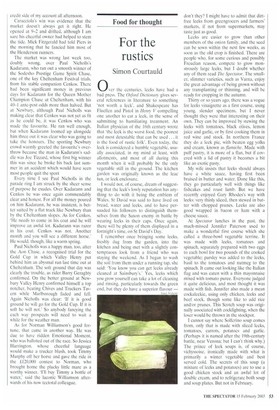Food for thought
For the rustics
Simon Courtauld
Over the centuries, leeks have had a bad press. The Oxford Dictionary gives several references in literature to something 'not worth a leek', and Shakespeare has Flueilen and Pistol in Henry V compelling one another to eat a leek, in the sense of submitting to humiliating treatment. An Italian physician of the 16th century wrote that 'the leek is the worst food, the poorest and most detestable that can be used ... it is the food of rustic folk'. Even today, the leek is considered a humble vegetable, usually associated, in my mind at least, with allotments, and most of all during this month when it will probably be the only vegetable still in the ground. The kitchen garden was originally known as the leac tun, or leek enclosure.
I would not, of course, dream of suggesting that the leek's lowly reputation has anything to do with it being the emblem of Wales. St David was said to have lived on bread, water and leeks, and to have persuaded his followers to distinguish themselves from the Saxon enemy in battle by wearing leeks in their caps. Once again, there will be plenty of them displayed in a fortnight's time, on St David's Day.
I remember once bringing some leeks, freshly dug from the garden, into the kitchen and being met with a slightly contemptuous look from a friend who was staying the weekend. As I began to wash the soil from them under a running tap, she said: 'You know you can get leeks already cleaned at Sainsbury's.' Yes, leeks which you grow yourself can take a lot of cleaning and rinsing, particularly towards the green end, but they do have a superior flavour —
don't they? I might have to admit that dirtfree leeks from greengrocers and farmers' markets, if not from supermarkets, may taste just as good.
Leeks are easier to grow than other members of the onion family, and the seed can be sown within the next few weeks, as soon as the old crop is finished. There are people who, for some curious and possibly Freudian reason, compete to grow monstrously large leeks, but I doubt whether any of them read The Spectator. The smaller, slimmer varieties, such as Varna, enjoy the great advantage of being grown without any transplanting or thinning, and will be ready for cropping in the autumn.
Thirty or so years ago, there was a vogue for leeks vinaigrette as a first course, using young, slender specimens, but I never thought they were that interesting on their own. They can be improved by stewing the leeks with tomatoes, black olives, lemon juice and garlic, or by first cooking them in red wine and stock. In northern France they do a leek pie, with beaten egg yolks and cream, known as flamiche. Made with puff pastry, it is more of a flan, but if covered with a lid of pastry it becomes a bit like an exotic pasty.
My wife insists that leeks should always have a white sauce, having first been braised in butter and water. Done like this, they go particularly well with things like fishcakes and roast lamb. But we have recently enjoyed Gary Rhodes's way with leeks: very thinly sliced, then stewed in butter with chopped prunes. Leeks are also good wrapped in bacon or ham with a cheese sauce.
At Spectator lunches in the past, the much-missed Jennifer Paterson used to make a wonderful first course which she called a three-bowl vegetable terrine. It was made with leeks, tomatoes and spinach, separately prepared with two eggs to each bowl for two pounds of the cooked vegetable; parsley was added to the leeks, basil to the tomatoes and nutmeg to the spinach. It came out looking like the Italian flag and was eaten with a thin mayonnaise mixed with tomato puree. Everyone judged it quite delicious, and most thought it was made with fish. Jennifer also made a mean cockaleekie, using only chicken, leeks and beef stock, though some like to add rice and/or prunes, This Scotch soup was originally associated with cockfighting, when the loser would be thrown in the stockpot.
I cannot say where Solferino soup comes from, only that is made with sliced leeks, tomatoes, carrots, potatoes and garlic. (Perhaps it is named after the 19th-century battle, near Verona; but I can't think why.) The prince of leek soups is, of course, vichyssoise, ironically made with what is primarily a winter vegetable and best served cold. The secrets of this soup (a mixture of leeks and potatoes) are to use a good chicken stock and an awful lot of double cream, and to refrigerate both soup and soup plates. But not in February.


































































 Previous page
Previous page